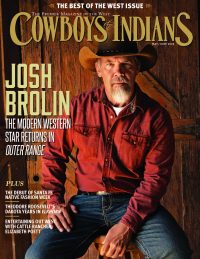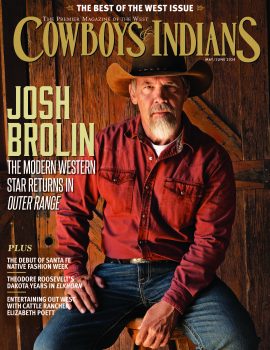Rather than being dubbed a "Native artist," this painter prefers to be seen as an artist who happens to be Native.
It’s hard to imagine words as cruel to a young creative spirit as those Western painter
John Potter heard from a high school art teacher who told him he’d never succeed. “She said I didn’t have the talent, the ambition,” the 58-year-old Ojibwe artist painfully recalls. “ ‘You should just go back to the reservation and be a drunk, like all the rest of ’em.’ ”
Those harsh words couldn’t have been more wrong. Today Potter’s award-winning landscapes, wildlife images, and Native American paintings are represented by some of the most prestigious art galleries in the American West. The fact that he was born for this profession is evidenced by his ever-present sketchpad. “It’s like, Why do I breathe?” he says, laughing. “I just gotta do it.”
Potter has been drawing since he was old enough to pick up a pencil. His growing-up years were split between the Lac du Flambeau Reservation in Wisconsin and the Chicago area, where he was a high school football star. But he admits that his youthful energy was sometimes misdirected. “Got in a bunch of trouble,” he confesses. “Indulged in a lot of stupid behavior.” Being of mixed blood compounded his confusion. But the wise advice of an Ojibwe uncle, Nick Hockings, led to a better path. “I asked him, ‘What do I gotta do to be, quote-unquote, a real Indian?’ And he said, ‘The real Indian left the reservation over 100 years ago. They’re out in the world and they’re free. So get out there and educate people about our culture, our religion, our spirituality, our art. And be a human being on this earth!’ ”

Potter went west, earning degrees at Utah State University in illustration and painting before becoming the newsroom illustrator for the Billings Gazette in Montana, a job that he says kept him drawing constantly. But the painting that occupied his free time demanded more attention. Finally, about 13 years ago, the illustrator committed himself to fine art full time.
A big break came when the National Museum of Wildlife Art in Jackson, Wyoming, invited Potter to exhibit at its prestigious Western Visions show (he’ll be included again this year), and later made Potter its artist in residence. “I owe a lot to that museum,” he says. “They’ve done a lot to further my career.”
Potter prefers to be known as an artist who happens to be Native, rather than as a “Native artist.” His heritage — the American Indian connection to nature — is a major influence. He favors a plein-air approach, often heading out into the countryside around his home in Red Lodge, Montana. “I really hope that my stuff can maybe open people’s hearts and eyes to the beauty of creation around us, because it’s everywhere.”
Potter’s work even opened the eyes of that hardhearted art teacher, who years later went to one of his shows and bought three pieces. “I reminded her what she said to me. And she said, ‘If I said that, it was only to inspire you to greatness.’ ”
Potter shakes his head at the memory. Did the critical comments motivate him? They certainly have helped him to encourage others over the years. “Don’t let anybody tell you you can’t do it,” he says. “If you’ve got this dream, let the dream work on you. Just pursue it.”
John Potter is represented by Mountain Trails Gallery in Jackson, Wyoming, and Sedona, Arizona; Big Horn Gallery in Cody, Wyoming; and Legacy Gallery in Bozeman, Montana. The Western Visions Show & Sale takes place September 5 – 27.
From the August/September 2015 issue.













